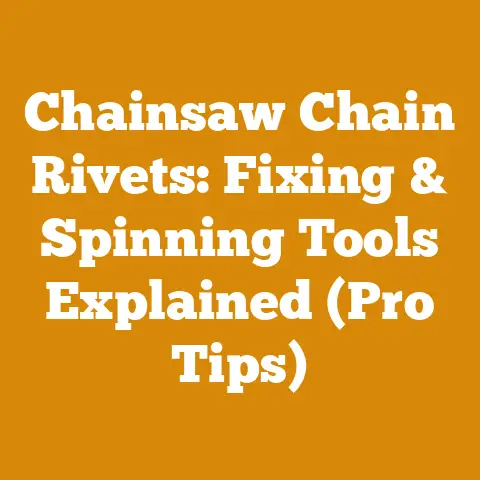576xp Husqvarna Chainsaw: Ultimate Guide for Precision Cutting (5 Pro Tips)
Imagine this: a tangled mess of overgrown branches, a fallen oak choking the life out of the surrounding saplings, and a winter looming with the promise of biting cold.
Now, picture this: a neatly stacked woodpile, seasoned logs ready to fuel a warm hearth, and a revitalized forest floor, sunlight dappling through the cleared canopy.
That transformation, from chaos to order, from potential hazard to valuable resource, is the power of a well-handled chainsaw, and in my experience, few chainsaws offer the precision and power of the Husqvarna 576XP.
As someone who’s spent years felling trees, processing timber, and preparing firewood – from the frosty forests of Scandinavia to the humid woodlands of the American South – I’ve come to rely on the right tools for the job.
The Husqvarna 576XP isn’t just a chainsaw; it’s a precision instrument capable of tackling demanding tasks efficiently and safely.
This guide is born from my hands-on experience, filled with the tips and tricks I’ve learned along the way, ensuring you get the most out of your 576XP.
The Husqvarna 576XP: An In-Depth Guide for Precision Cutting
This guide aims to transform you from a novice intimidated by the roar of a chainsaw into a confident operator capable of precision cutting.
We’ll cover everything from understanding the chainsaw’s mechanics to mastering felling techniques, all while prioritizing safety.
Understanding Your Chainsaw: Key Components and Terminology
Before you even think about firing up the 576XP, it’s crucial to understand its anatomy.
Let’s break down the key components and define some essential terms:
- Engine: The heart of the chainsaw, typically a two-stroke engine requiring a mix of gasoline and oil.
The 576XP boasts a powerful engine designed for demanding tasks. - Bar: The guide bar is the metal rail that supports and guides the chain.
Bar length determines the maximum cutting diameter. - Chain: The cutting element, consisting of interconnected links with sharp cutters.
Different chain types are designed for various cutting applications. - Sprocket: A toothed wheel that drives the chain around the bar.
- Clutch: Engages and disengages the engine from the chain.
- Chain Brake: A safety mechanism that stops the chain instantly in case of kickback.
- Throttle: Controls the engine speed.
- Choke: Helps start the engine by restricting airflow, creating a richer fuel mixture.
- Air Filter: Prevents dust and debris from entering the engine.
- Fuel Tank: Holds the gasoline and oil mixture.
- Oil Tank: Holds chain oil for lubrication.
- Bumper Spikes (Felling Dogs): Metal spikes used to pivot and control the chainsaw during felling.
- Anti-Vibration System: Reduces vibration, minimizing operator fatigue.
Key Terms:
- Green Wood: Freshly cut wood with high moisture content.
- Seasoned Wood: Wood that has been allowed to dry, reducing its moisture content.
Seasoned wood burns more efficiently and produces less smoke. - Kickback: A dangerous situation where the chainsaw bar is thrown upwards and backwards towards the operator.
- Felling: The process of cutting down a tree.
- Limbing: Removing branches from a felled tree.
- Bucking: Cutting a felled tree into shorter lengths.
The 576XP: Why Choose This Chainsaw?
The Husqvarna 576XP is a professional-grade chainsaw renowned for its power, durability, and reliability.
I’ve found it particularly well-suited for:
- Felling medium to large trees: Its powerful engine and long bar can handle substantial timber.
- Limbing and bucking: The balanced design and responsive throttle make it easy to maneuver.
- Firewood preparation: Its robust construction ensures it can withstand the rigors of processing large quantities of wood.
- Storm cleanup: When storms leave a trail of fallen trees, the 576XP is a reliable partner.
Technical Specifications (Typical):
- Engine Displacement: 73.5 cc
- Power Output: 4.2 kW (5.7 hp)
- Recommended Bar Length: 18-28 inches
- Weight (without bar and chain): 6.6 kg (14.5 lbs)
While specifications can vary slightly depending on the model year and configuration, these figures provide a general overview of the 576XP’s capabilities.
Safety First: Essential Gear and Precautions
Before you even think about starting the engine, safety is paramount.
I can’t stress this enough: a chainsaw is a powerful tool, and mishandling it can lead to serious injury.
Essential Safety Gear:
- Chainsaw Helmet: Protects your head from falling branches and debris.
Look for a helmet with a face shield and ear protection. - Eye Protection: Safety glasses or goggles are crucial to prevent wood chips and sawdust from entering your eyes.
- Hearing Protection: Chainsaws are loud; earplugs or earmuffs will protect your hearing.
- Chainsaw Chaps or Pants: Made of ballistic nylon, these protect your legs from accidental contact with the chain.
- Gloves: Provide a secure grip and protect your hands from cuts and abrasions.
- Steel-Toed Boots: Protect your feet from falling logs and potential chainsaw injuries.
Pre-Operation Checklist:
- Inspect the chainsaw: Check for loose parts, damaged components, and a sharp chain.
- Sharpen the chain: A dull chain is more likely to kick back.
- Check fuel and oil levels: Ensure both tanks are full.
- Clear the work area: Remove any obstacles that could trip you or interfere with your work.
- Know your surroundings: Be aware of trees, power lines, and other potential hazards.
- Never work alone: Always have someone nearby in case of an emergency.
I once witnessed a near-fatal accident when a colleague, rushing to finish a job before dark, skipped the safety checks and ignored a cracked chain.
The chain broke during a cut, narrowly missing his face.
That incident reinforced the importance of meticulous preparation and unwavering adherence to safety protocols.
Preparing Your 576XP: Fuel, Oil, and Chain Maintenance
Proper preparation is essential for optimal performance and longevity.
Fuel Mixture:
The 576XP, like most two-stroke chainsaws, requires a mixture of gasoline and two-stroke oil.
The correct ratio is crucial for engine lubrication and performance.
Husqvarna typically recommends a 50:1 ratio (50 parts gasoline to 1 part oil). Always use high-quality two-stroke oil specifically designed for air-cooled engines.
Mixing Fuel:
- Use a clean fuel can.
- Pour the correct amount of two-stroke oil into the can.
- Add gasoline to reach the desired ratio.
- Shake the can thoroughly to mix the fuel.
Chain Oil:
Use a high-quality chain oil specifically designed for chainsaw lubrication.
Chain oil reduces friction between the chain and the bar, extending the life of both components.
I recommend using a bar and chain oil with tackifiers, which help the oil adhere to the chain even at high speeds.
Chain Tension:
Proper chain tension is essential for safe and efficient cutting.
A loose chain can derail, while a tight chain can overheat and damage the bar and sprocket.
Checking Chain Tension:
- Wear gloves.
- Pull the chain away from the bar at the midpoint of the bar’s underside.
- The chain should pull away slightly, but the drive links (the parts of the chain that fit into the bar groove) should still remain in the groove.
Adjusting Chain Tension:
- Loosen the bar nuts that secure the bar to the chainsaw.
- Use the chain tensioning screw (typically located on the side of the chainsaw) to adjust the chain tension.
- Tighten the bar nuts securely.
- Recheck the chain tension.
Chain Sharpening:
A sharp chain is crucial for safe and efficient cutting.
A dull chain requires more force, increases the risk of kickback, and produces rough cuts.
Tools for Chain Sharpening:
- Round File: Used to sharpen the cutting teeth.
The file size depends on the chain pitch (the distance between the chain rivets). - File Guide: Helps maintain the correct filing angle and depth.
- Depth Gauge Tool: Used to adjust the depth gauge (raker) height.
- Flat File: Used to adjust the depth gauges.
Sharpening Procedure:
- Secure the chainsaw in a vise or on a stable surface.
- Use the round file and file guide to sharpen each cutting tooth.
Maintain the correct filing angle and depth. - Check the depth gauge height with the depth gauge tool.
- If necessary, use the flat file to adjust the depth gauges.
I’ve found that investing in a good quality chain sharpener, whether manual or powered, pays dividends in terms of cutting efficiency and safety.
A sharp chain not only cuts faster but also reduces operator fatigue and the risk of kickback.
Starting Your 576XP: A Step-by-Step Guide
Starting a chainsaw can be intimidating for beginners, but with the right technique, it becomes second nature.
Starting Procedure:
- Engage the chain brake. This prevents the chain from moving during starting.
- Place the chainsaw on a stable surface. Ensure the bar and chain are clear of any obstructions.
- Activate the choke. The choke enriches the fuel mixture for easier starting.
- Hold the chainsaw firmly. Use your left hand to grip the front handle and your right foot to secure the rear handle.
- Pull the starter cord. Pull the cord sharply and smoothly until the engine starts.
- Disengage the choke. Once the engine starts, disengage the choke.
- Let the engine warm up. Allow the engine to idle for a few minutes before using the chainsaw.
- Test the chain brake. Before making any cuts, test the chain brake to ensure it is functioning properly.
Troubleshooting Starting Problems:
- Engine won’t start: Check the fuel level, spark plug, and air filter.
- Engine starts but dies: Check the fuel mixture and carburetor settings.
- Engine runs poorly: Check the air filter and spark plug.
I remember struggling to start my first chainsaw, convinced it was faulty.
It turned out I was flooding the engine by pulling the starter cord too many times with the choke engaged.
Patience and a methodical approach are key.
Felling Techniques: Mastering the Art of Tree Cutting
Felling a tree is a complex and potentially dangerous task that requires careful planning and execution.
Planning the Fell:
- Assess the tree: Determine the tree’s lean, size, and any defects (e.g., dead branches, rot).
- Identify hazards: Look for power lines, buildings, roads, and other potential hazards.
- Plan your escape route: Determine a clear path away from the falling tree.
- Check the weather: Avoid felling trees in high winds or other adverse weather conditions.
Felling Cuts:
- Notch Cut (Undercut): A wedge-shaped cut made on the side of the tree in the direction you want it to fall.
The notch cut should be about one-third of the tree’s diameter. - Hinge: The uncut wood between the notch cut and the back cut.
The hinge controls the direction of the fall. - Back Cut: A horizontal cut made on the opposite side of the tree from the notch cut.
The back cut should be slightly higher than the bottom of the notch cut.
Felling Procedure:
- Make the notch cut. Use a precise and controlled motion.
- Make the back cut. Leave a hinge of sufficient width to control the fall.
- Insert wedges (if necessary). Wedges can help to direct the fall and prevent the saw from binding.
- Monitor the tree’s movement. Watch for signs that the tree is starting to fall.
- Retreat along your escape route. Move quickly and safely away from the falling tree.
Important Considerations:
- Lean: Trees with a significant lean require special techniques.
- Wind: Wind can significantly affect the direction of the fall.
- Size: Larger trees require more planning and caution.
I once had to fell a large oak tree that was leaning precariously towards a neighbor’s house.
I used a combination of wedges and a pulling cable attached to a tractor to ensure the tree fell in the desired direction.
It was a nerve-wracking experience, but careful planning and execution ensured a safe and successful outcome.
Limbing and Bucking: Processing Felled Trees
Once a tree is felled, the next step is to limb and buck it into manageable lengths.
Limbing:
- Work from the base of the tree towards the top. This allows you to stand on the trunk for stability.
- Use a firm grip and controlled movements.
- Be aware of spring poles. These are branches that are bent under tension and can snap back when cut.
- Cut branches close to the trunk.
Bucking:
- Determine the desired length of the logs.
- Use a measuring tape or stick to mark the cut lines.
- Consider the weight of the logs. Avoid cutting logs that are too heavy to handle.
- Use proper bucking techniques to prevent the saw from binding.
Bucking Techniques:
- Overbucking: Cutting from the top down.
- Underbucking: Cutting from the bottom up.
- Combination Bucking: Using both overbucking and underbucking techniques.
Preventing Binding:
- Support the log. Use wedges or other supports to prevent the log from pinching the saw.
- Make relief cuts. These are small cuts that relieve tension in the wood.
I remember struggling to buck a large log that was lying on uneven ground.
The saw kept binding, and I was getting frustrated.
I finally realized that I needed to support the log with wedges to prevent it from pinching the saw.
Simple solutions can often make a big difference.
Firewood Preparation: From Log to Hearth
Preparing firewood is a rewarding but labor-intensive process.
The 576XP excels at this task, but proper technique is essential for efficiency and safety.
Splitting Wood:
- Use a maul or splitting axe for smaller logs.
- Use a hydraulic log splitter for larger logs.
- Wear safety glasses and gloves.
- Split wood on a stable surface.
- Use proper splitting techniques to avoid injury.
Splitting Techniques:
- Aim for the center of the log.
- Use a controlled swing.
- Keep your feet firmly planted.
- Avoid splitting wood near other people.
Stacking Firewood:
- Stack firewood in a well-ventilated area.
- Stack firewood off the ground to prevent rot.
- Stack firewood in a stable manner to prevent it from collapsing.
- Allow firewood to season for at least six months before burning.
Seasoning Firewood:
- Seasoning reduces the moisture content of the wood.
- Seasoned wood burns more efficiently and produces less smoke.
- Seasoning time depends on the type of wood and the climate.
Typical Seasoning Times:
- Softwoods (e.g., pine, fir): 6-12 months
- Hardwoods (e.g., oak, maple): 12-24 months
I’ve experimented with different firewood stacking methods and found that a simple “holzhaufen” style stack, where the logs are stacked in a circular pattern, provides excellent ventilation and stability.
It also looks quite aesthetically pleasing!
5 Pro Tips for Precision Cutting with the 576XP
Now, let’s get to those pro tips I promised:
- Master the plunge cut: The plunge cut is a technique where you bore into the wood with the tip of the bar.
It’s useful for felling trees with a lean and for creating notches.
Practice on a scrap piece of wood before attempting it on a tree.
I recommend starting with a small diameter log (6-8 inches) and gradually increasing the size as you become more confident. - Use wedges strategically: Wedges are your best friend when felling trees.
They can help to direct the fall and prevent the saw from binding.
Carry a variety of wedge sizes and shapes.
I always keep at least three wedges of different sizes with me: a small plastic wedge for minor adjustments, a medium-sized steel wedge for more aggressive direction, and a large felling axe wedge for the really stubborn trees. - Maintain your chain religiously: A sharp chain is essential for precision cutting.
Sharpen your chain frequently, even if it doesn’t seem dull.
A few strokes with a file after each tank of gas can make a big difference.
I’ve also found that rotating between two or three chains extends their overall lifespan, as it allows each chain to cool down and prevents excessive wear. - Listen to your chainsaw: Your chainsaw will tell you when something is wrong.
Pay attention to the engine’s sound and vibration.
If you notice anything unusual, stop cutting and investigate.
A change in the engine’s tone can indicate a dull chain, a clogged air filter, or even a more serious problem. - Practice, practice, practice: The best way to improve your chainsaw skills is to practice.
Start with small projects and gradually work your way up to more challenging tasks.
The more time you spend using your chainsaw, the more comfortable and confident you will become.
I started by simply bucking firewood and progressed to felling small trees.
Over time, I developed a feel for the chainsaw and learned to anticipate its behavior.
Case Study: Revitalizing a Neglected Woodlot
Let me share a personal experience that highlights the power of precision cutting and responsible wood management.
A few years ago, I acquired a small, neglected woodlot choked with overgrown brush and diseased trees.
The area was a fire hazard and provided little habitat for wildlife.
My goal was to revitalize the woodlot, creating a healthier and more productive ecosystem.
I started by selectively thinning the trees, removing diseased and overcrowded specimens.
Using the 576XP, I carefully felled each tree, paying close attention to the direction of the fall to avoid damaging other trees or the surrounding vegetation.
I then limbed and bucked the felled trees, using the wood for firewood and construction projects.
The remaining branches and debris were chipped and used as mulch.
The result was a dramatic transformation.
The woodlot was now open and airy, with sunlight reaching the forest floor.
New seedlings began to sprout, and wildlife returned to the area.
This project demonstrated the importance of precision cutting and responsible wood management.
By carefully selecting which trees to remove and using the wood wisely, I was able to improve the health and productivity of the woodlot while also providing valuable resources.
Troubleshooting Common Issues with the 576XP
Even the best chainsaws can experience problems from time to time.
Here are some common issues and how to troubleshoot them:
- Chainsaw won’t start:
- Possible Causes: Empty fuel tank, stale fuel, fouled spark plug, clogged air filter, flooded engine.
- Solutions: Fill the fuel tank with fresh fuel, replace the spark plug, clean the air filter, allow the engine to dry out if flooded.
- Chainsaw starts but stalls:
- Possible Causes: Clogged fuel filter, incorrect carburetor settings, loose spark plug wire.
- Solutions: Replace the fuel filter, adjust the carburetor settings (consult the owner’s manual), tighten the spark plug wire.
- Chainsaw chain is dull:
- Possible Causes: Chain has been used to cut dirty or abrasive materials, chain has not been sharpened properly.
- Solutions: Sharpen the chain using a file or chain sharpener, replace the chain if it is severely worn.
- Chainsaw is leaking oil:
- Possible Causes: Loose oil cap, damaged oil line, worn oil pump.
- Solutions: Tighten the oil cap, replace the damaged oil line, replace the worn oil pump.
- Chainsaw is vibrating excessively:
- Possible Causes: Loose bar nuts, damaged anti-vibration mounts, worn chain.
- Solutions: Tighten the bar nuts, replace the damaged anti-vibration mounts, replace the worn chain.
Beyond the Basics: Advanced Techniques and Applications
Once you’ve mastered the fundamentals, you can explore more advanced techniques and applications:
- Humboldt Cut: A felling technique used for trees with a strong lean.
- Back Cut First: A felling technique used in specific scenarios to control the fall.
- Using a Winch: Employing a winch to assist in felling trees in difficult locations.
- Milling Lumber: Using a chainsaw mill to convert logs into lumber.
- Wood Carving: Using a chainsaw for artistic wood carving.
The Future of Chainsaw Technology
Chainsaw technology is constantly evolving.
Battery-powered chainsaws are becoming increasingly popular, offering quieter operation and reduced emissions.
Advancements in chain design and materials are improving cutting efficiency and durability.
Smart chainsaws with integrated sensors and diagnostics are also emerging, providing valuable data on chainsaw performance and maintenance needs.
Conclusion: Empowering You with Precision Cutting Skills
The Husqvarna 576XP is a powerful and versatile tool that can transform your wood processing and firewood preparation capabilities.
By understanding its mechanics, mastering essential techniques, and prioritizing safety, you can unlock its full potential and achieve precision cutting with confidence.
Remember, practice makes perfect.
Start with small projects, gradually increase the difficulty, and never stop learning.
With dedication and the right tools, you can transform yourself from a novice into a skilled chainsaw operator, capable of tackling demanding tasks efficiently and safely.
Now, go forth and transform that chaos into order, that potential hazard into a valuable resource.
Your warm hearth awaits!






